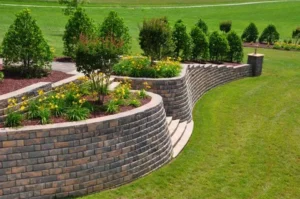Retaining walls are essential structures designed to hold back soil and prevent erosion, commonly used in landscaping projects to create terraces, level out sloped yards, or provide structural support to landscapes. These walls not only serve functional purposes but also add aesthetic appeal to outdoor spaces.
Understanding Retaining Walls Installation
Importance of Proper Installation
Proper installation of retaining walls Installation is crucial to ensure their durability and effectiveness. A well-installed retaining wall can withstand the pressures exerted by soil and water, providing long-term stability to the landscape.
Factors to Consider Before Installation
Before embarking on the installation process, several factors need consideration, including the type of soil, the height of the wall, drainage requirements, and any local regulations or permits needed for construction.
Step-by-Step Guide to Installing Retaining Walls
Preparing the Site
The first step in installing a retaining wall is preparing the site. This involves clearing the area of vegetation, debris, and any obstacles that may hinder construction. Additionally, the ground should be leveled and compacted to provide a stable foundation for the wall.
Choosing the Right Materials
Selecting the appropriate materials is crucial for the success of the project. Materials such as concrete blocks, natural stone, or timber are commonly used for constructing retaining walls Installation, each offering unique advantages in terms of durability, aesthetics, and cost.
Building the Foundation
The foundation serves as the base of the retaining wall, providing stability and support. Depending on the soil conditions and the height of the wall, the foundation may need to be reinforced with gravel, drainage pipes, or geogrids to enhance its strength.
Constructing the Wall
Once the foundation is in place, the construction of the wall can begin. This involves stacking the chosen materials in a staggered pattern, ensuring proper alignment and interlocking to create a sturdy structure.
Backfilling and Drainage
After the wall is constructed, it is essential to backfill the space behind it with gravel or soil to provide additional support and stability. Proper drainage is also critical to prevent water buildup behind the wall, which can lead to erosion and structural damage.
Common Mistakes to Avoid During Installation
Poor Drainage
Inadequate drainage can result in water accumulation behind the retaining wall Installation, exerting excessive pressure and causing it to fail over time. Proper drainage systems, such as weep holes or French drains, should be incorporated into the design to channel water away from the wall.
Incorrect Backfilling
Improper backfilling techniques can compromise the stability of the retaining wall. It is essential to use the appropriate type of backfill material and compact it evenly to prevent settling and erosion.
Inadequate Foundation Preparation
A solid foundation is essential for the structural integrity of the retaining wall. Failing to properly prepare the foundation can result in settlement, tilting, or even collapse of the wall. Thorough site analysis and soil testing should be conducted to determine the optimal foundation design.
Benefits of Professional Installation Services
While some homeowners may attempt to install retaining walls themselves, hiring professional installation services offers several advantages. Professionals have the expertise, experience, and equipment necessary to ensure that the wall is installed correctly, minimizing the risk of costly mistakes and future repairs.
Maintenance Tips for Retaining Walls
To prolong the lifespan of retaining walls, regular maintenance is essential. This includes inspecting the wall for signs of damage, such as cracks or bulging, and addressing any issues promptly. Additionally, maintaining proper drainage and keeping the area behind the wall free of debris can help prevent erosion and structural deterioration.
Conclusion
Retaining walls are valuable additions to any landscape, providing both functional and aesthetic benefits. Proper installation is crucial to ensure the durability and effectiveness of these structures, and homeowners should carefully consider factors such as site preparation, materials, and drainage requirements before undertaking a retaining wall project. By following the steps outlined in this article and avoiding common installation mistakes, homeowners can enjoy the benefits of a well-built retaining wall for years to come.
FAQs
- How long does it take to install a retaining wall?
- The time required to install a retaining wall depends on various factors such as the size of the wall, the chosen materials, and site conditions. On average, the installation process can take anywhere from a few days to a couple of weeks.
- Can I install a retaining wall myself, or should I hire a professional?
- While it is possible to install a retaining wall yourself, hiring a professional installation service is recommended, especially for larger or more complex projects. Professionals have the expertise and equipment to ensure that the wall is installed correctly, minimizing the risk of structural issues in the future.
- What materials are commonly used for retaining walls Installation?
- Retaining walls can be constructed using a variety of materials, including concrete blocks, natural stone, timber, and brick. Each material offers unique advantages in terms of durability, aesthetics, and cost, allowing homeowners to choose the option that best suits their needs and preferences.
- Do retaining walls require maintenance?
- Yes, retaining walls require regular maintenance to ensure their longevity and effectiveness. This includes inspecting the wall for signs of damage, maintaining proper drainage, and keeping the area behind the wall free of debris.
- Are retaining walls subject to building regulations or permits?
- In many areas, retaining walls are subject to local building regulations and may require permits before construction can begin. Homeowners should check with their local authorities to determine the specific requirements and regulations governing retaining wall construction in their area.
